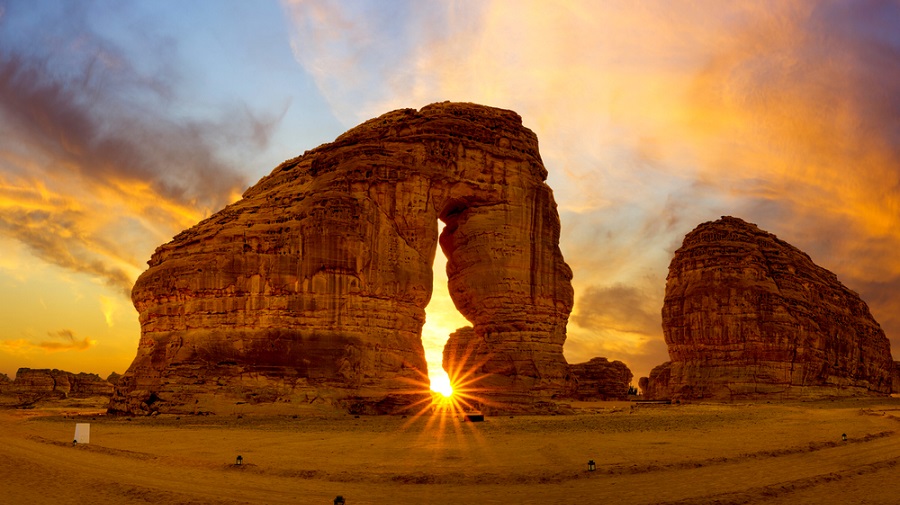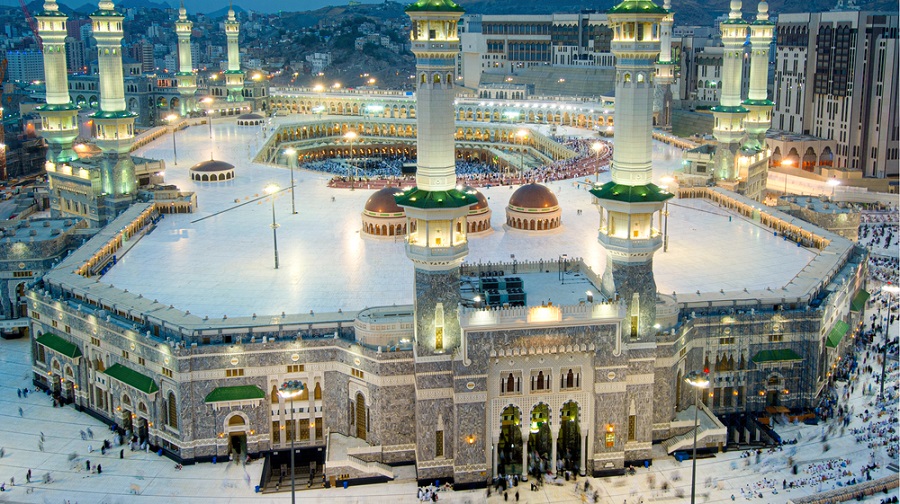
For decades, Saudi Arabia remained a land shrouded in mystique, a destination whispered about but rarely explored by the mainstream tourist. However, the Kingdom is undergoing a profound transformation, opening its doors to the world and revealing a treasure trove of historical marvels, breathtaking natural landscapes, and a burgeoning modern culture. From ancient Nabataean cities to glittering futuristic skylines, Saudi Arabia offers an unparalleled journey through time and tradition, beckoning the adventurous traveler to discover its hidden gems.
A Tapestry Woven with History:
The history of Saudi Arabia is as vast and rich as its desert landscapes. It is the cradle of Islam, a land of prophets and pilgrimage. For centuries, Mecca and Medina have been the spiritual heart of the Muslim world, drawing millions of faithful each year. But the region’s historical significance extends far beyond religious devotion.
Related Articles about Beyond the Veil: Unveiling the Wonders of Saudi Arabia for the Discerning Traveler:
- Myanmar: A Journey Through Time, Culture, and Unforgettable Landscapes
- Switzerland: A Journey Through Alpine Majesty and Urban Charm
- The Great White North Beckons: A Comprehensive Guide to Experiencing the Best of Canada
- Finland: A Traveler’s Guide to the Land of a Thousand Lakes and Endless Wonders
- Indonesia: A Tapestry of Wonders – Unveiling the Best Tourist Attractions
The Arabian Peninsula was a vital crossroads for ancient trade routes, connecting the East and West. Civilizations flourished here, leaving behind an indelible mark. The Nabataeans, masters of desert architecture, carved magnificent cities into sandstone cliffs, most famously at Al-Hijr (Madain Saleh). Later, the region was part of various empires, including the Roman and Ottoman, each contributing to its complex cultural mosaic.
The modern Kingdom of Saudi Arabia was founded by King Abdulaziz Ibn Saud in 1932, uniting disparate tribes and regions under one banner. This unification marked the beginning of a new era, one that has witnessed immense progress and a growing desire to share its unique heritage with the global community.
Unveiling the Crown Jewels: Main Tourist Attractions
Saudi Arabia’s attractions are as diverse as its geography, offering something to captivate every traveler:
1. Al-Hijr (Madain Saleh) – The Nabataean Masterpiece:
Often referred to as the "Mada’in Salih," this UNESCO World Heritage site is Saudi Arabia’s first. Located in the northwest, it boasts over 111 remarkably preserved tombs carved into sandstone outcrops, dating back to the 1st century AD. The sheer scale and intricate detail of these facades, reminiscent of Petra in Jordan, are awe-inspiring. Exploring the ancient wells, sacrificial altars, and the iconic Qasr al-Farid (The Lonely Castle) offers a profound glimpse into the Nabataean civilization.
2. Riyadh – The Dynamic Capital:
Riyadh, the Kingdom’s bustling capital, is a fascinating blend of tradition and modernity. Dominating the skyline are iconic structures like the Kingdom Centre Tower with its distinctive sky bridge offering panoramic city views, and the Al Faisaliah Centre with its globe-shaped observation deck. For a taste of history, visit the Masmak Fortress, a clay and mud-brick citadel that played a pivotal role in the country’s unification. The National Museum of Saudi Arabia provides a comprehensive overview of the Kingdom’s rich history, culture, and art. Don’t miss the vibrant Souq Al Zal, a traditional market where you can haggle for carpets, spices, and local handicrafts.
3. Jeddah – The Gateway to the Red Sea:
Jeddah, the Kingdom’s second-largest city and a major port on the Red Sea, offers a different flavor. Its historic Al-Balad district, another UNESCO World Heritage site, is a labyrinth of coral stone buildings with intricately carved wooden balconies, a testament to its past as a thriving trade hub and the gateway for pilgrims to Mecca. Stroll along the vibrant Jeddah Corniche, a picturesque waterfront promenade dotted with sculptures, parks, and stunning views of the Red Sea. For underwater enthusiasts, the Red Sea boasts some of the world’s most vibrant coral reefs and diverse marine life, making snorkeling and diving a must-do activity.
4. Al-Ula – The Ancient Oasis:
Nestled in the northwest, Al-Ula is an archaeological wonderland. Beyond Al-Hijr, this region is home to a vast open-air museum of ancient civilizations. Explore the Dadanite and Lihyanite kingdoms, marvel at the Elephant Rock (Jabal Al Fil), a naturally formed rock formation resembling an elephant, and discover ancient inscriptions and tombs scattered across the landscape. Al-Ula is rapidly developing as a cultural and eco-tourism destination, offering unique experiences like stargazing and luxury desert camps.
5. Mecca and Medina – The Spiritual Epicenter:
While primarily destinations for religious pilgrimage, Mecca and Medina hold immense historical and cultural significance for Muslims worldwide. The Masjid al-Haram in Mecca, home to the Kaaba, and the Prophet’s Mosque in Medina are sacred sites of unparalleled importance. Non-Muslims are generally not permitted entry into the holy cities, but understanding their spiritual significance is key to comprehending the fabric of Saudi society.
6. Abha and the Asir Region – The Mountain Retreat:
Escape the desert heat and discover the lush, mountainous landscapes of the Asir region in the southwestern part of the Kingdom. Abha, the capital, is known for its cooler climate, vibrant art scene, and traditional "Art Street." Explore the ancient mud-brick villages perched on hilltops, such as the picturesque village of Rijal Almaa, offering a glimpse into traditional Saudi architecture and rural life. The Sarawat Mountains provide opportunities for hiking and breathtaking vistas.
7. The Empty Quarter (Rub’ al Khali) – The Majestic Desert:
For the truly adventurous, the Empty Quarter is an unparalleled experience. This vast expanse of sand dunes is the largest contiguous sand desert in the world. Exploring its raw beauty through dune bashing, camel trekking, and overnight camping under a canopy of stars is an unforgettable adventure, offering a profound connection with the untamed spirit of Arabia.
Navigating Your Journey: Travel Tips for Saudi Arabia
Saudi Arabia has made significant strides in easing travel for tourists. Here are some essential tips:
- Visa: Tourists can now obtain e-visas or visas on arrival for many nationalities. It’s advisable to check the latest visa requirements for your country well in advance of your trip.
- Dress Code: While dress codes have relaxed considerably, modest attire is still recommended, especially outside of major cities and tourist resorts. For women, covering shoulders and knees is generally appreciated, and a headscarf is optional but can be worn if preferred. Men should avoid shorts in public places.
- Respect Local Customs: Saudi Arabia is a Muslim country with deeply ingrained cultural traditions. Be mindful of prayer times, avoid public displays of affection, and be respectful of local customs and etiquette.
- Alcohol: The sale and consumption of alcohol are strictly prohibited in Saudi Arabia.
- Photography: Always ask for permission before photographing people, especially women.
- Language: Arabic is the official language. English is widely spoken in tourist areas, hotels, and by younger generations. Learning a few basic Arabic phrases can be appreciated.
- Currency: The Saudi Riyal (SAR) is the official currency. Credit cards are widely accepted in most establishments.
- Connectivity: Wi-Fi is readily available in hotels and many public places. Purchasing a local SIM card is also an affordable option for data and calls.
The Perfect Time to Explore: Best Time to Visit
The best time to visit Saudi Arabia largely depends on your tolerance for heat and your desired activities.
- Winter (November to March): This is the most pleasant time to visit, with cooler temperatures across the Kingdom. Riyadh and the central regions experience mild days and cooler evenings, while the north can be quite chilly. This is ideal for exploring historical sites, outdoor activities, and enjoying the desert.
- Spring (April to May) and Autumn (September to October): These shoulder seasons offer a good balance of pleasant temperatures, though they can still be warm. These are also good times to visit, especially for those who prefer slightly warmer weather.
- Summer (June to August): Summers in Saudi Arabia are extremely hot, particularly in the interior regions like Riyadh. The coastal areas, like Jeddah, can be humid and hot. If you plan to visit during summer, focus on indoor attractions, air-conditioned malls, and coastal activities where sea breezes might offer some respite.
Comfort and Convenience: Nearby Hotels
Saudi Arabia offers a wide range of accommodation options, from luxury international hotel chains to charming boutique guesthouses and desert camps.
- Riyadh: You’ll find world-class hotels like the Four Seasons, St. Regis, and The Ritz-Carlton, as well as mid-range options and business-oriented hotels.
- Jeddah: Options range from beachfront resorts like the Rosewood Jeddah to business hotels and apartments.
- Al-Ula: Glamping experiences and luxury resorts are becoming increasingly popular, offering unique stays amidst the ancient landscape. Consider the Habitas AlUla or Banyan Tree AlUla.
- Desert Camps: For an authentic desert experience, consider booking an overnight stay in a desert camp, often found near major attractions like Al-Ula.
A Taste of Arabia: Local Food
Saudi cuisine is a delicious reflection of its nomadic heritage and influences from across the Middle East and Asia.
- Kabsa: The national dish, a fragrant rice dish cooked with spices, meat (chicken, lamb, or camel), and often served with a side of salad and yogurt.
- Mandi: Another popular rice and meat dish, slow-cooked in a tandoor-like pit, resulting in tender and flavorful meat.
- Shawarma: Thinly sliced grilled meat (chicken or lamb) wrapped in flatbread with vegetables and sauces.
- Muttabaq: A savory or sweet flatbread, often filled with meat, cheese, or bananas.
- Dates: Saudi Arabia is renowned for its high-quality dates, available in countless varieties. They are a staple and a delicious treat.
- Arabic Coffee (Gahwa): Served with cardamom and often accompanied by dates, it’s a symbol of hospitality.
- Fresh Juices: Abundant and refreshing, especially during warmer months.
Getting Around: Transportation Options
Saudi Arabia has a developing transportation infrastructure, making it increasingly easy to navigate.
- Air Travel: For longer distances between major cities, domestic flights are efficient and widely available. Saudi Arabian Airlines (Saudia) and Flynas are the main carriers.
- Road Travel:
- Rental Cars: Renting a car is a popular option, especially for exploring at your own pace. International driving permits are generally accepted. Roads are well-maintained, particularly between major cities.
- Taxis and Ride-Sharing: Taxis are readily available in cities, and ride-sharing apps like Uber and Careem are very popular and affordable.
- Buses: Inter-city bus services connect most major towns and cities, offering a budget-friendly option.
- Trains: The Haramain High-Speed Railway connects Mecca, Medina, Jeddah, and King Abdullah Economic City, offering a fast and comfortable way to travel between these key locations. Other rail networks are also expanding.
The Dawn of a New Era:
Saudi Arabia is shedding its past perceptions and embracing a future that celebrates its rich heritage while welcoming global visitors. From the ancient whispers of Al-Hijr to the modern pulse of Riyadh, the Kingdom offers a journey of discovery, a chance to immerse yourself in a culture that is both deeply traditional and rapidly evolving. So, pack your curiosity, open your mind, and prepare to be captivated by the wonders of Saudi Arabia – a destination poised to surprise and delight every traveler.








